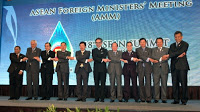Brandon Smith, Contributing Writer
Activist Post
One of the most frustrating issues to haunt the halls of alternative economic analysis is the threat of misrepresentative terminology. For instance, when the U.S. government decided to back the private Federal Reserve in lowering the interest rates on lending windows to European banks last month, they did not call this a bailout, even though that’s exactly what it was. They did not call it quantitative easing, or fiat printing, or a hyperinflationary landmine; rarely does bureaucracy ever apply honest terminology to their subversive activities. False terminology is the bane of every honest analyst, because in order for them to educate and awaken those who are unaware of the truth, they must first battle through the daunting muck of the general public’s horrifically improper perceptions and vocabulary.
The chain of financial events taking place over the past decade in Asia has been correspondingly mislabeled and misunderstood. What some economists see as total collapse is actually a new and decidedly prophetic (or engineered) transition. What some naively see as the “natural” progression of globalism, is actually a distinctly deliberate program of centralization meant to further the goals of world economic and political totalitarianism. Asia, and most especially China, is a Petri dish for elitist psychopaths. What we see as suffocating collectivism in this region of the world today is the exact social schematic intended for the West tomorrow. Call it whatever you will, but on the other side of the Pacific, like the eerie smile of a sinister clown, sits fabricated fate.
The genius of globalization is not in how it “works”, but in how it DOESN’T work. Globalization chains together mismatched cultures through circumstance and throws us into the deep end of the pool. If one sinks, we all sink, enslaving us with interdependency. The question one must ask, then, is whether sovereign economies are currently tied together in the same way? The answer is no, not anymore. Certain countries have moved to insulate themselves from the domino effect of debt implosion; one of the primary examples being China.
Since at least 2005, China has been taking the exact steps required to counter the brunt of a global debt collapse; not enough to make it untouchable, but enough that its infrastructure will survive. One could even surmise that China’s actions indicate a foreknowledge of the events that would eventually escalate in 2008. How they knew is hard to say, but if the available evidence causes you to lean towards collapse as a Hegelian creation (and it should if you are paying any attention), then China’s activity begins to make perfect sense. If a globalist insider told you that in a few short years the two most powerful financial empires in the world were going to topple like bowling pins under the weight of their own liabilities, what would you do? Probably separate yourself as much as possible from the diseased dynamic and construct your own replacement system. This is what China has done….
China started with the circulation of Yuan-denominated bonds, like T-Bonds, meant to securitize Chinese debt, creating an outlet for the currency to go global. China’s considerable forex and bond reserves make this move a rather suspicious one. With so much savings at their disposal, why bother to issue bonds at all? Why threaten the traditional export-based economy and the uneven trade advantage that the country had been thriving on for decades? The success of Chinese bonds would mean the internationalization of the Yuan, a floating valuation of the currency, and the loss of the desirable trade deficit with the United States. Back in 2005, this all would surely seem like a novelty that was going nowhere fast. Of course, today China’s actions suggest an unprecedented push to convert to a consumer hub at the center of a massive trading bloc. To put it simply; China knew ahead of schedule that the U.S. was no longer going to be a viable customer, and reliance on such a country would spell disaster. They have been preparing to break away from America’s consumer markets and the dollar for some time.
 In 2008, after China announced the use of the Yuan in cross-border trade on a limited basis, I began to write about the possibility that China was preparing to break from the Greenback. For the past few years my primary focus in terms of finance has been the East as a kind of warning bell for the state of the global economy. In 2009 and 2010, it became absolutely clear that China (with the help of global corporate entities) was developing the skeleton of a new system; a trade network that that had the capacity to supplant the U.S. and end the dollar’s world reserve status.
In 2008, after China announced the use of the Yuan in cross-border trade on a limited basis, I began to write about the possibility that China was preparing to break from the Greenback. For the past few years my primary focus in terms of finance has been the East as a kind of warning bell for the state of the global economy. In 2009 and 2010, it became absolutely clear that China (with the help of global corporate entities) was developing the skeleton of a new system; a trade network that that had the capacity to supplant the U.S. and end the dollar’s world reserve status.
Since then, Yuan bonds have spread across the planet, China has dropped the dollar in bilateral trade with Russia, the ASEAN trading bloc has formed into a tight shell of export partners, and that is just the beginning. Two major announcements in 2011 have solidified my belief that a complete dump of the dollar by Eastern interests is near…
First was the announcement that China was actively and openly pursuing the establishment of a central bank for the whole of ASEAN, with the Yuan utilized as the reserve currency instead of the dollar:
http://www.reuters.com/article/2011/10/27/us-china-asean-financial-idUSTRE79Q2F520111027
This news, of course, has barely been reported on in the mainstream. As I discussed at the beginning of this article, the terminology surrounding economic developments has been diluted and twisted. When China states that an ASEAN central bank is in the works, we need to point out what this really means; the ASEAN trading bloc is about to become the Asian Union. The only missing piece of the puzzle is something that I have been warning about for at least a couple years, ever since my days at Neithercorp (see “Migration Of The Black Swans” as a recent example). This key catalyst is the inclusion of Japan in ASEAN, something which many said would take five to ten years to unfold. News released this Christmas speaks otherwise:
Japan has indeed entered into an agreement to drop the dollar in currency exchange with China and has expressed interest in melting into ASEAN. Japan has also struck somewhat similar though slightly more limited deals with India, South Korea, Indonesia, and the Philippines almost simultaneously:
 This means that the two largest foreign holders of U.S. debt and Greenbacks will soon be in a position to tap into an export market far more profitable than that of America, and that all of this trade will be facilitated by currencies OTHER THAN THE DOLLAR. It means the end of the dollar as the world reserve, and probably the end of the dollar as we know it.
This means that the two largest foreign holders of U.S. debt and Greenbacks will soon be in a position to tap into an export market far more profitable than that of America, and that all of this trade will be facilitated by currencies OTHER THAN THE DOLLAR. It means the end of the dollar as the world reserve, and probably the end of the dollar as we know it.
Japan’s inclusion in this process was inevitable. With its economy already in steep deflationary decline, the Yen skyrocketing in value against the dollar making exports difficult, as well as the ongoing nuclear meltdown problem at Fukushima, the island nation has been on the edge of complete collapse. Its only option, therefore, is to sink into the chaotic seas, or float like a buoy tied to an Asian Union. There can be absolutely no doubt now that Japan will soon implement the latter solution.
The dilemma at this point becomes one of timing. Now that we are certain that two of the largest economies in the world are about the dump the Greenback, what signals can we watch when preparing for the event? My belief is that the trigger will come squarely from the U.S. and the Federal Reserve, either as legislation to heavily tax Asian imports, a renewed threat of further credit downgrades like that which S&P brought down in August, or the announcement of more open quantitative easing. Any and all of these issues could very well arise in the course of the next 6-12 months, QE3 being a basic no-brainer. ASEAN could, certainly, drop the dollar immediately after their central bank apparatus is put in place, resulting in a much more volatile trade war atmosphere (also useful for full global centralization later down the road). The point is, we are truly at a place in our economic life when ANYTHING is possible.
My hope is that as our predictions in the alternative economic community are proven correct with every passing quarter, more Americans will take note, and prepare. I can say quite confidently that we have entered the first stages of the catastrophic phase of the economic implosion. All the fantastic and terrible consequences many once considered theory or science fiction, are about to become reality.
Practical solutions have been offered by myself and many others. The only thing left now is to take action, or ride the tidal wave of destruction like so much driftwood. We can help to determine the outcome, or we can be idle spectators. In everything, there is a choice….
Brandon Smith is the founder of Alt-Market is an organization designed to help you find like-minded activists and preppers in your local area so that you can network and construct communities for mutual aid and defense. Join Alt-Market.com today and learn what it means to step away from the system and build something better or contribute to their Safe Haven Project. You can contact Brandon Smith at: brandon@alt-market.com
linkwithin_text=’Related Articles:’



Be the first to comment on "New Asian Union Means The Fall Of The Dollar"